Meet 15 influential women in Madison's history
Featured Stories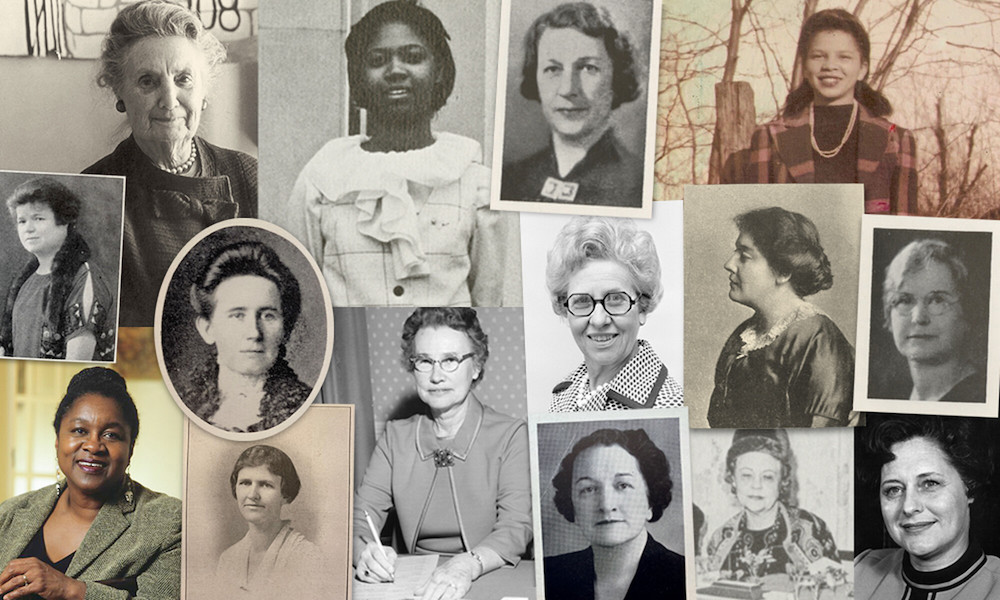
SUMMARY: Of the countless women who left their mark on this institution over the years as students, faculty and staff members, and community leaders, 15 have their names memorialized on campus buildings.
This article and other exclusive content is available in the Madison app. ![]()
Doris Harper Allen (’19H): Author, teacher, activist and celebrated historian
Once barred from attending Madison College because of her race, Allen worked as a cook for President G. Tyler Miller and his family for 16 years before graduating from Marshall University in the 1970s. She worked as an early childhood teacher in West Virginia and eventually returned to her hometown of Harrisonburg. There she became heavily involved in revitalization efforts in the city’s Northeast neighborhood after urban renewal projects of the 1960s closed Effinger Street School, the all-Black school she had attended in her youth.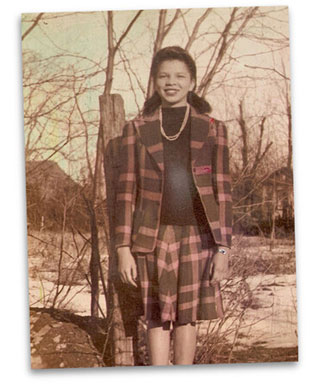
Allen became a highly respected teacher, community leader and local historian who contributed to multiple JMU-sponsored commemorative projects. She published two books, including her memoir, The Way It Was, Not the Way It Is.
During the era of racial segregation, Allen was taught by accomplished and longtime teacher Lucy F. Simms at Effinger Street School in the months before Simms’ death in 1934. Because of Allen’s personal connection to Simms, who was born into slavery around 1857 but went on to graduate from Hampton Normal and Agricultural Institute (later Hampton University) with a teaching certificate of the first degree and teach for 56 years, Allen honored her by collaborating on the “Celebrating Simms” exhibit, a joint venture with the Shenandoah Valley Black Heritage Center in the fall of 2015 that pays tribute to Simms’ teaching career and life.
Before Allen died in 2021, she received an honorary doctorate from JMU for her years of service to the Madison and Harrisonburg communities. Harper Allen-Lee Hall is named after Allen and Robert Walker Lee, a beloved maintenance worker at Madison College.
Katherine M. Anthony: A memorable and knowledgeable educator
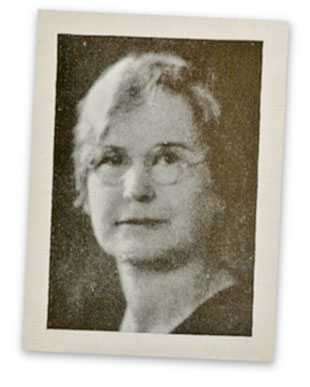
In 1919, Anthony worked at the State Normal School for Women in Harrisonburg as a teacher and the new director of the training division. Described by author Raymond C. Dingledine Jr. in his book Madison College: The First Fifty Years, 1908 – 1958 as enthusiastic, friendly, knowledgeable and inquisitive, she was remembered by her students long after graduation.
From 1927 to 1935, she taught Organizing Materials for Teaching, and a few years later, she began advising the school’s newly established chapter of the Association for Childhood Education. She also taught classes in remedial reading.
In 1944, she was recommended by President Samuel Page Duke to be one of nine members commissioned by the Virginia General Assembly to study the public school system and teacher training. She would be appointed to the panel by Gov. Colgate W. Darden.
Anthony-Seeger Hall is named for her and fellow teacher Mary Louise Seeger.
Mary Louise Seeger: Tireless kindergarten teacher instructor and Student Government adviser in the 1930s
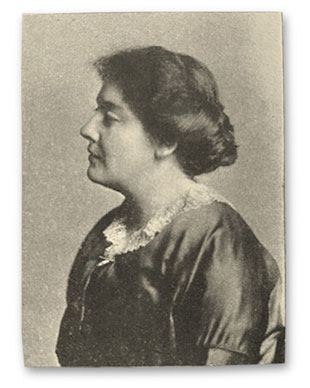
Seeger took over the Kindergarten Training program from the previous instructor starting in 1913. She taught for four decades and was praised for her untiring energy, ready wit and practicality.
In 1916, at a series of joint meetings between the State Normal School for Women and Harrisonburg High School, Seeger spoke on “The Niceties of Life and How to Teach Them.” The policy adopted by the joint meetings, later called The Educational Society of Harrisonburg, was continued through the end of President Julian A. Burruss’ administration in 1919.
In the 1930s, Seeger served as a Student Government adviser, retiring in 1952.
Built in the winter of 1957-58, the Anthony-Seeger School, a nursery and elementary school, was named in recognition of the two teachers, who contributed greatly to elementary education at Madison College. It operated on the JMU campus until 1982.
Elizabeth P. Cleveland: Influential English teacher and school founder
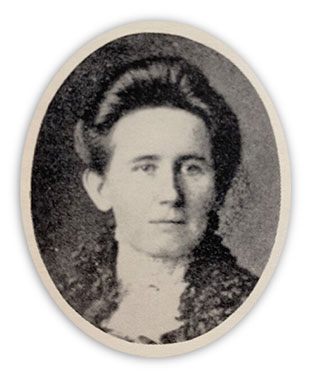
A decade after Cleveland started at the State Normal and Industrial School for Women in 1909 as head of the English and literature department, the faculty had grown from 15 to 27, and she was one of only four founding teachers who remained. Before starting at the school, she already had 20 years of teaching experience, but she devoted another 44 to the school, which became the State Teachers College in 1924 and then Madison College in 1938.
Contributing in various ways to the early development of the Normal School, Cleveland aimed for a different, finer experience than other girls’ schools. She was strict in academics and in presentation, leading a special English class in spelling and composition in 1910 to address what she determined were poor language skills among the school’s first cohort. She also promoted proper dress among the students and led the faculty in its stance against forming sororities.
In her first summer, she helped originate plans to organize literary societies, which continued until the early 1940s, when the school started allowing sororities. In the 1930s, she switched to teaching French.
Adviser to the Lanier Literary Society, one of several campus literary societies that planned extracurricular activities like debates, essays, readings and special music, Cleveland helped plan what became the school’s first yearbook, the Schoolma’am. In 1922, she offered the name The Breeze for the student newspaper, which won out over Campus Cat.
Cleveland served as chairperson of the Student Publications Committee that supervised the Schoolma’am until her retirement in 1943.
In 1957, Junior Hall was renamed Cleveland Hall in her memory and renovated a year later.
Agness (Stribling) Dingledine: Beloved alumnae secretary, dorm mother and first Student Association president
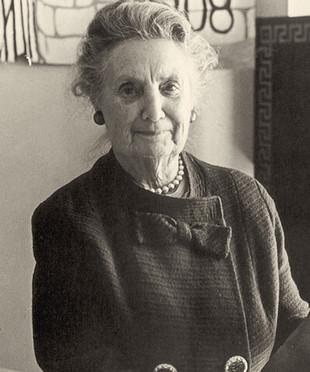
In 1913, Agness Stribling of Petersburg, Virginia, enrolled in the two-year teaching certificate program at the State Normal and Industrial School for Women. She became chairperson of the Honor Committee and was installed as the first president of the school’s Student Association. In 1917, she became the school’s youngest faculty member and the following year married math professor Raymond C. Dingledine Sr.
In 1949, she mentored students as a dormitory hostess in Sprinkle House and became house mother of Tri Sigma sorority from 1949 to 1962, a role that earned her the affectionate moniker of “Mama Ding.” Three years later, she became alumnae secretary, serving until her retirement in 1967.
To commemorate the legacy and achievements of the Dingledine family, various scholarships have been established over the years, including the Agness S. Dingledine Memorial Scholarship in 1974. The scholarship was enhanced in 1999 by her grandson, Tom Dingledine.
Dingledine Hall, a residence hall, was built in 1968 in The Village area of campus.
Joanne V. Gabbin: Furious Flower founder, scholar and first Black director of Honors Program
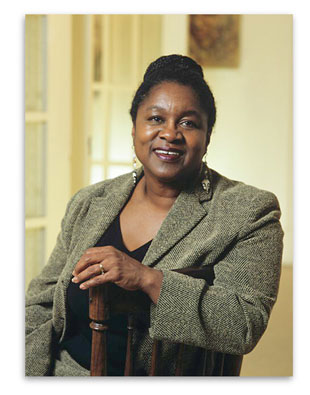
Gabbin is best remembered as founder and executive director of the Furious Flower Poetry Center, the nation’s first academic center dedicated to Black poetry. But she also served as director of the JMU Honors Program for 19 years, laying the groundwork for it becoming a college in 2016.
Before joining the English faculty at JMU in 1985, Gabbin taught at Roosevelt University, Chicago State University and Lincoln University.
In 1994, she hosted the first Furious Flower Poetry Conference in honor of Pulitzer Prize-winning poet Gwendolyn Brooks. After a second successful conference a decade later, JMU chartered the Furious Flower Poetry Center in 2005.
Gabbin has authored numerous books, and she founded the Wintergreen Women’s Writers’ Collective, making significant contributions to the field of African American poetry that have earned her various awards and honors.
She received Outstanding Teaching Awards at JMU and is a nationally recognized scholar in her field. She’s also active in the Harrisonburg community, helping improve relations with the university.
Gabbin Hall is named for her and her husband, Alexander Gabbin, longtime professor of Accounting.
Dorothy (Spooner) Garber (1920): An important early connection between alumnae and staff
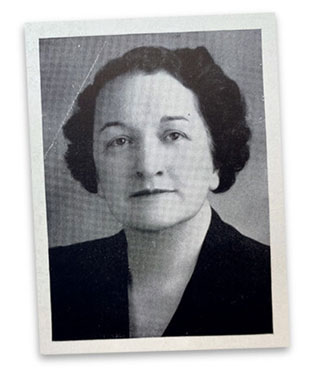
Garber, who was first hired in 1924 to teach chemistry and then returned in 1928 from a year of absence to teach General Science and serve as alumnae secretary, offered a critical early connection between alumnae and staff.
As a student, she held various top offices, including president of the Student Association, class president and leader of the Stratford Literary Society. She earned praise from the Schoolma’am, which said “[her] unfailing good humor, practical sense and inimitable wit make up a personality that is irresistible to man and maid alike,” adding, “We wonder how the place will go on without her.”
After graduating, she was a science teacher at the local high school for two years before being hired by the new State Teachers College. She also served as alumnae secretary from 1928 to 1933 and from 1940 to 1951.
In 1940, she became Madison College’s first dean of freshmen, and in 1949, she implemented a policy for having carefully selected senior counselors work with new students. She and her counselors developed a new welcome booklet for freshmen.
Garber Hall opened as a residence hall in 1969, honoring the time and effort that its namesake had devoted to the school.
Martha S. Grafton: Longtime dean, history teacher and advocate for higher education
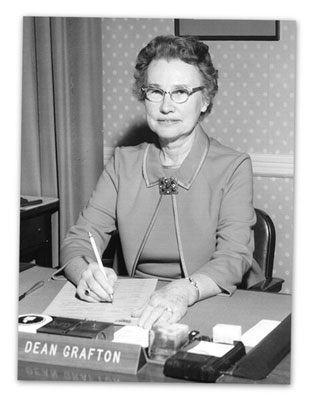
Martha (Stackhouse) Grafton, a South Carolina native, was dean of Mary Baldwin College starting in the 1930s, professor emerita of sociology for many years and a member of the JMU Board of Visitors in the 1970s. Grafton died in 2005 at the age of 96.
Born in 1908, Grafton earned a bachelor’s in history from Agnes Scott College and a master’s in history from Northwestern University.
She was 21 in 1930 when she started working at Mary Baldwin as a History instructor and assistant dean of students. In 1938, she was named dean of the college and served as assistant to the president during World War II. She was also a registrar and served as acting president in 1945, 1953 and 1969. In 1970, she retired from the office of Dean of the College and in 1971 retired from the faculty.
For many years she lived in Staunton, Virginia, before moving to a Harrisonburg retirement community in 1991. She was a member of the Staunton City School Board for 14 years and, after retiring, spent several years on Mary Baldwin’s Advisory Board of Visitors.
Grafton served on the JMU Board of Visitors from 1970 to 1978. The Grafton-Stovall Theatre, built as a movie theater in 1979, was named for her and another former member of the board, businessman David H. Stovall of Virginia Beach, Virginia. In addition to movies, the theater is used for lectures and special programs.
Margaret Vance Hoffman: Trusted literary adviser, horse handler and leader of sorority push
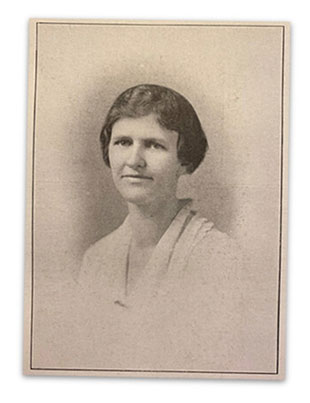
Hoffman was hired in 1911 to teach Latin and German and help in the English department. She remained at the school for the next 43 years.
Hoffman was elected an honorary member of the sophomore class for the 1916-17 year, but she declined the next year when the junior class attempted to reelect her. They had a custom at the time of having both an honorary and advisory member each year, and when she decided that a man would add more dignity to the honorary title, the students designated her as their advisory member instead.
The school produced annual theater productions, and in 1916 Hoffman helped supervise their most ambitious production to date, Gilbert and Sullivan’s H.M.S. Pinafore, in Assembly Hall, with participation from the household arts department’s teacher and some of the men in town.
Hoffman regularly taught a quarter of Children’s Literature and in the 1930s started stabling horses at Camp Strawderman in Edinburg, Virginia, to offer riding to students.
In 1939, Hoffman led the faculty in allowing sororities on campus after student sentiment had increased. As a sponsor of the Page Literary Society, she encouraged members of that group, plus girls from the other societies, to petition for establishment of a chapter of Sigma Sigma Sigma (Tri Sigma). An Alpha Sigma Alpha chapter also started that spring, and three years later, the school’s literary societies were discontinued.
Hoffman Hall, which opened as a residence hall in 1964, was named in her honor.
Sheary Darcus Johnson (’70, ’74M): Longtime library science teacher who desegregated Madison College
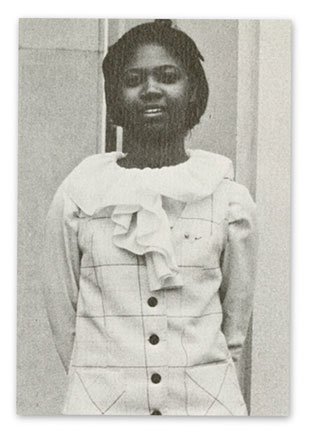
Johnson was this institution's first Black graduate. Because of Virginia’s policy of resistance to desegregation, the college didn’t admit Johnson until 1966, 11 years after the Brown v. Board of Education decision and two years after Harrisonburg schools desegregated.
As a student at the Lucy F. Simms School, Johnson realized that “separate but equal” really meant secondhand books and less educational opportunities than her white peers. Her father, Pastor Henry Darcus Sr., was supportive of her interest in attending college and met with the local school board to request her enrollment. In 1964, she and five others became the first Black students to attend Madison, which was officially integrated the next year.
Johnson had a generally positive experience at Madison, but she did not live on campus. She attributed much of her success to living at her parents’ home in Harrisonburg.
Johnson earned a master’s degree from Madison in 1974 and a doctorate from the University of Virginia in 1988. She taught library science at Virginia Commonwealth University, wrote several books and started nonprofits to help others achieve their goals.
Darcus Johnson Hall, formerly Jackson Hall, first opened as Dormitory No. 1 in 1909 and was named by the Class of 1913 at its fifth reunion. Later the home of the history department following a renovation in 1971, the building was renamed in 2021 to honor Johnson.
Nellie L. Long (’49): Dedicated Duke and volunteer
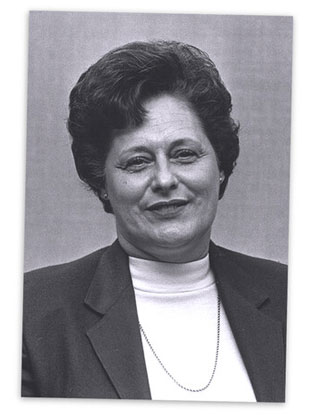
Nellie L. Long, of Edinburg, Virginia, was president of the JMU Alumni Board of Directors in 1983. The following year, McGraw-Long Hall opened in honor of her and Walter J. McGraw, former rector of the Board of Visitors. Long served on the Board of Visitors from 1972 to 1980 and took part in the Carrier Library groundbreaking ceremony in 1979.
Pearl P. Moody: Persistent supervisor of Virginia’s first ‘Practice House’ for home economics students
Before becoming head of the home economics department in 1923, Moody taught classes in cooking, foods and nutrition. She quickly started work on a campus “practice house” that would become the first of its kind in Virginia.
Using a suite of three rooms — bedroom, dining room and kitchen — as a model, Moody invited six girls to move into Smythe House, which the school rented on adjoining property, with her as supervisor and her young son, Jim, as a means for the girls to gain child-care experience.
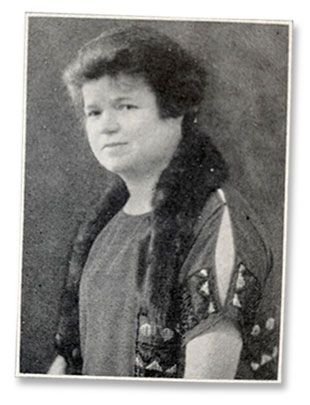
In 1921, President Samuel Page Duke convinced the school to purchase Smythe House and convert it into a residence hall, offering temporary quarters for the practice house around campus until a permanent practice house could be built. Moody took great care in supervising almost every detail of the build, including the selection of drapes and furnishings. The duplex, called Home Management House, was ready for students in 1929, 13 years after its conception.
Moody continued as department head until 1940, and taught until her retirement in 1948. She was instrumental in establishing the department as outstanding in its field.
Moody Hall opened in 1961 and housed the home economics department in Moody’s honor. Since then, the building has housed other departments too and now houses the Blackwell Auditorium.
Inez (Graybeal) Roop (’35): Longtime JMU benefactor who shined a light on past campus wrongs
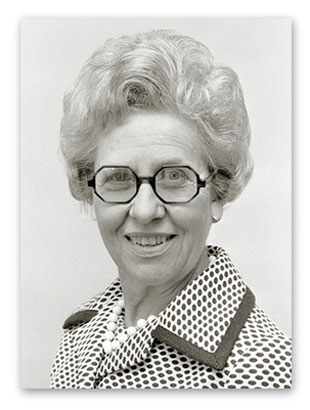
A lifelong educator, Roop made her mark on Madison for more than 75 years as a student, graduate, teacher and devoted benefactor.
In 1977, Roop, then a Board of Visitors member, made the motion to change the name of Madison College to James Madison University and was present at the March 22, 1977, ceremonial signing by Gov. Mills Godwin.
After serving as president of the Richmond Chapter of Madison College Alumni and a member of the JMU Alumni Association Board of Directors, she was appointed to a four-year term on the Madison College Board of Visitors in 1974. In 1980, she was reappointed to a second four-year term.
She also brought to light alumni papers documenting the initiation ritual of JMU’s Lee Literary Society — one of the first two societies formed by the State Normal School for Women — that required new members to wear blackface and dress in mammy caricature.
For years, she taught public school in Covington and Montgomery County, Virginia, then passed on her extensive knowledge and values of commitment, self-discipline and service to family members at her farm in southwest Virginia.
In 1977, she was awarded the Distinguished Alumni Service Award, which was renamed in 2003 as the Inez Graybeal Roop Distinguished Alumni Service Award. At the time of her death in 2010 at the age of 97, 142 Roop scholarships had been awarded to students.
She attended her 75th class reunion in 2010 and marched in the JMU centennial parade representing the Class of 1935. She also fiercely supported the JMU basketball team and enjoyed football, attending games at JMU and Virginia Tech with her husband, a Tech graduate.
Roop Hall was built in 1980 as the home of the College of Education. The building now houses the Department of Mathematics and Statistics.
Bernice R. Varner: Impetuous dean of women and campus trendsetter
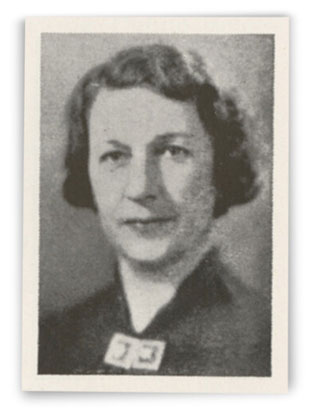
Varner, a social director who became dean of women in 1923, was strict enough to refuse a student permission to fly in a young man’s airplane but spontaneous enough to go up in the plane herself when she saw how disappointed the pilot was. When the pilot buzzed President Samuel Page Duke’s golf game, the president was ready to “have the fool arrested” until he learned his dean of women had been in the plane.
Varner also changed minds about campus fashion, allowing students and teachers to openly sport bobbed hair after she returned from a meeting in Atlantic City, New Jersey, with the hairstyle. Seeing her new hairdo, Duke gave up the fight against shorter hair and allowed others to follow her example.
Varner resigned as dean in 1930 before returning for about 25 years as part of the home economics department and becoming a mainstay with the Home Management House. Everyone knew her high standards for academics and preparedness, and students found her lessons stimulating. In 1940, she took over as head of the department, and, offering a great sense of humor and genuine interest in “her” girls, she was affectionately known as “Aunt Bernice” to many graduates.
Under Varner’s advisory that started in 1943, the Panhellenic Council supervised and coordinated various sorority activities.
Varner also headed the Civilian Defense Committee, which was appointed by Duke after the bombing of Pearl Harbor. The committee, composed of students and faculty, provided various Red Cross courses, and teachers volunteered to present the classes for several interested students. The committee later added a comprehensive plan of defense activities which, in accordance with requests from Washington, D.C., included physical fitness, war projects, civilian morale and understanding of current problems. The program was called off in April 1943 after enthusiasm waned.
Varner Hall was built in 1929 as the “Practice House” for students studying the art of housekeeping. By the 1970s, it was being used for administrative offices. It now houses the office of Planning, Analytics and Institutional Research (formerly the Office of Institutional Research.)
Helen Mugler White (’25): Award-winning journalist and founding member of alumni chapter
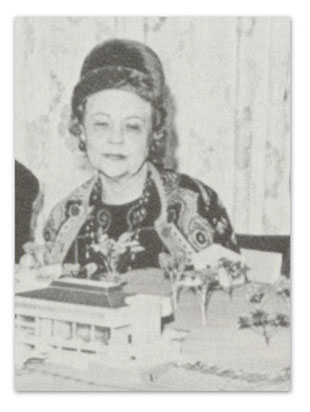
White, a Newport News, Virginia, journalist and educator, served on the JMU Board of Visitors from 1964 to 1974 and was vice-rector from 1966 to 1974. One of the founding members of the Richmond Alumni Chapter, she was also named the 1962 Virginia Press Woman of the Year.
For several years, the Junior Women’s Club of Hilton Village of Tidewater gave a yearly $600 scholarship in White’s name to honor its club sponsor, who dedicated herself to civic work, especially in the area of scholastic achievement. Fittingly for White’s alma mater, the club required that the recipient be female.
Built in 1973, White Hall was the last residence hall to be constructed in The Village.
